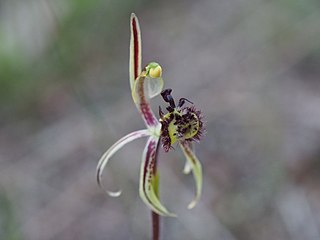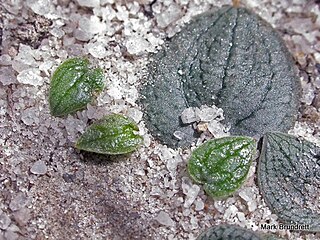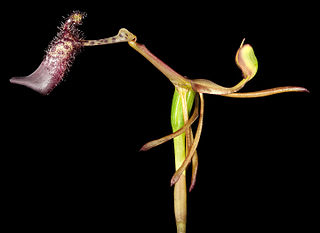
Caladenia, commonly known as spider orchids, is a genus of 350 species of plants in the orchid family, Orchidaceae. Spider orchids are terrestrial herbs with a single hairy leaf and a hairy stem. The labellum is fringed or toothed in most species and there are small projections called calli on the labellum. The flowers have adaptations to attract particular species of insects for pollination. The genus is divided into three groups on the basis of flower shape, broadly, spider orchids, zebra orchids and cowslip orchids, although other common names are often used. Although they occur in other countries, most are Australian and 136 species occur in Western Australia, making it the most species-rich orchid genus in that state.

Drakaea is a genus of 10 species in the plant family Orchidaceae commonly known as hammer orchids. All ten species only occur in the south-west of Western Australia. Hammer orchids are characterised by an insectoid labellum that is attached to a narrow, hinged stem, which holds it aloft. The stem can only hinge backwards, where the broadly winged column carries the pollen and stigma. Each species of hammer orchid is pollinated by a specific species of thynnid wasp. Thynnid wasps are unusual in that the female is flightless and mating occurs when the male carries a female away to a source of food. The labellum of the orchid resembles a female thynnid wasp in shape, colour and scent. Insect pollination involving sexual attraction is common in orchids but the interaction between the male thynnid wasp and the hammer orchid is unique in that it involves the insect trying to fly away with a part of the flower.

Spiculaea is a genus of plants defined by a single species, Spiculaea ciliata, commonly known as elbow orchid, and allied to the family Orchidaceae. Endemic to the south-west of Western Australia, the species is unusual in a number of respects; it grows in shallow soil on granite rock outcrops, grows and flowers in the hottest months of the year and has a unique method of using thynnid wasps as pollinators.

Caleana, commonly known as duck orchids, is a genus of flowering plants in the orchid family, Orchidaceae that is found in Australia and New Zealand. The Australian species are found in all states but have not been recorded in the Northern Territory. Duck orchids have a single leaf and one or a few, dull-coloured, inconspicuous flowers. Most species are found in Western Australia but one species occurs in eastern Australia and one occurs in eastern Australia and New Zealand. Orchids in this genus as well as the hammer orchids (Drakaea) are pollinated by male thynnid wasps.

Caladenia barbarossa, commonly known as the common dragon orchid is a species of orchid endemic to the south-west of Western Australia. It can be distinguished by its distinctive labellum which is attractive to species of male thynnid wasps.
Drakaea concolor, commonly known as the kneeling hammer orchid, is a species of orchid endemic to the south–west of Western Australia. The species is only known from a few areas in the far west of the state and has been declared "vulnerable" by the Australian Government and "threatened" by the Government of Western Australia.
Drakaea confluens, commonly known as late hammer orchid is a species of orchid endemic to the south–west of Western Australia. It is similar to other hammer orchids in that it is pollinated by a single species of male thynnid wasp using sexual deception. The orchid's labellum is similar in shape and scent to a specific species of flightless female thynnid wasp. The species was discovered and collected in 1930 but was not formally described until 2007. It is only known from three areas in the south of the state and has been declared "endangered" by the Australian government and "threatened" by the Government of Western Australia.

Drakaea elastica, commonly known as glossy-leaved hammer orchid or praying virgin is a species of orchid endemic to the south–west of Western Australia. It is similar to other hammer orchids in that it is pollinated by a single species of male thynnid wasp using sexual deception. The orchid's labellum is similar in shape and scent to a flightless female thynnid wasp. The glossy-leaved hammer orchid was the first in the genus to be described. The species is only known from the far south-west of the state and has been declared "endangered" by both the Australian government and the government of Western Australia.

Drakaea glyptodon, commonly known as king in his carriage is a species of orchid endemic to the south–west of Western Australia. It is pollinated by a single species of male thynnid wasp using sexual deception. The orchid's labellum is similar in shape and scent to a flightless female thynnid wasp. It is the most common drakaea and has the widest distribution.

Drakaea gracilis, commonly known as slender hammer orchid, is a species of orchid endemic to the south–west of Western Australia. It is pollinated by a single species of male thynnid wasp using sexual deception. The orchid's labellum is similar in shape and scent to a flightless female thynnid wasp. It was first collected in 1900 but other names were given to it, including Drakaea elastica and D. fitzgeraldii. It was not until 2007 when studies of the drakaeas and their pollinators were carried out, that the present species was recognised as distinct.

Drakaea isolata, commonly known as lonely hammer orchid is a species of orchid endemic to the south–west of Western Australia. It is pollinated by a single species of male thynnid wasp using sexual deception. The orchid's labellum is similar in shape and scent to a flightless female thynnid wasp. It is known from only one population and has been declared "endangered" by the Australian government and "threatened" by the government of Western Australia. It was first collected in 1984 by Robert J. Bates. No other Drakaea species is found it the same area but the broad-billed duck orchid is found nearby.

Drakaea livida, commonly known as warty hammer orchid, is a species of orchid endemic to the south–west of Western Australia. It is pollinated by a single species of male thynnid wasp using sexual deception. The orchid's labellum is similar in shape and scent to a flightless female thynnid wasp. Although the species was formally described in 1842, the description was often later overlooked and other hammer orchids were given the name Drakea livida. It is now known to be, along with Drakaea glyptodon, one of the most widespread of the genus.

Drakaea thynniphila, commonly known as narrow-lipped hammer orchid is a species of orchid endemic to the south–west of Western Australia. It is pollinated by a single species of male thynnid wasp using sexual deception. The orchid's labellum is similar in shape and scent to a flightless female thynnid wasp. It is one of the more common drakaeas and is easily distinguished from the other species. The tiny lumps on its leaf along with the long flower that lacks a swollen labellum are diagnostic.
Drakaea andrewsiae, commonly known as the lost hammer orchid is a species of orchid endemic to the south–west of Western Australia. The species was first collected in 1930, has only been collected on two other occasions and photographed a few other times. It was, however, not formally described until 2007. No living examples of this species have been observed since 6 October 2000.

Arthrochilus latipes, commonly known as robust elbow orchid, is a flowering plant in the orchid family (Orchidaceae) and is endemic to the "Top End" of the Northern Territory in Australia. Each plant has from two to four ground-hugging leaves and between three and fifteen flowers during the wet season and the species often forms spreading colonies on sandstone escarpments. Like others in the genus, the flowers are pollinated by a species of thynnid wasp.

Caladenia abbreviata, commonly known as the coastal spider orchid, is a plant in the orchid family Orchidaceae and is endemic to the south-west of Western Australia. It has a single erect, hairy leaf and up to three pale, creamy-yellow flowers on a flowering stem up to 35 cm (10 in) high. Although the flowers have long, thread-like petals and sepals, they are shorter and darker than those of other spider orchids. It is a rare, relatively recently discovered species although often found near human activities.
Caladenia drakeoides, commonly known as the hinged dragon orchid is a species of orchid endemic to the south-west of Western Australia. It has a single hairy leaf and a single greenish-yellow and red flower with a hinged labellum resembling a female thynnid wasp.

Caladenia huegelii, commonly known as the grand spider orchid is a species of orchid endemic to the south-west of Western Australia. It has a single, hairy leaf and up to three relatively large red, green and cream-coloured flowers which have "split-hairs" on the sides of the labellum.

Caleana dixonii, commonly known as the sandplain duck orchid is a rare species of orchid endemic to the south-west of Western Australia. It has a single smooth leaf and a single greenish yellow and fawn-coloured flower. It is distinguished by its flattened labellum with calli only near the tip of the labellum and its preference for growing on sandplains.

Arthrochilus huntianus, commonly known as common elbow orchid, is a flowering plant in the orchid family (Orchidaceae) and is endemic to south-eastern Australia. It has no leaves but an insect-like flower which has its labellum dangling like a lure away from the rest of the flower. Because of its thin, wiry stem and small, dull-coloured flowers, this orchid is difficult to locate. Like others in the genus, the flowers are pollinated by a species of thynnid wasp. Some authorities use the name Thynninorchis huntiana for this orchid.
















